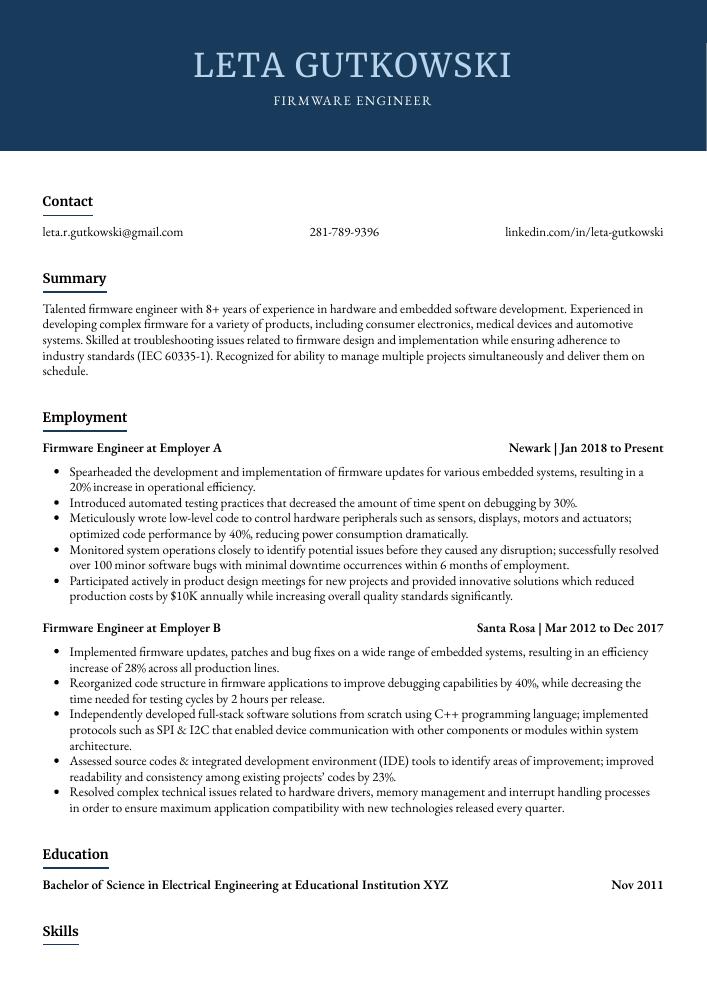Firmware Engineer Resume Guide
Firmware Engineers work to develop and maintain software that is embedded into hardware devices. They analyze user needs, design firmware architectures, write code for device drivers and applications, debug programs, test system performance, and create technical documentation. Furthermore they collaborate with electrical engineers to ensure compatibility between hardware components and software systems.
Your firmware engineering skills are unparalleled, and you have the perfect set of qualifications for any tech firm that needs a skilled engineer. But to make sure potential employers know your abilities, you must carefully craft an impressive resume.
This guide will walk you through the entire process of creating a top-notch resume. We first show you a complete example and then break down what each resume section should look like.
Table of Contents
The guide is divided into sections for your convenience. You can read it from beginning to end or use the table of contents below to jump to a specific part.
Firmware Engineer Resume Sample
Leta Gutkowski
Firmware Engineer
[email protected]
281-789-9396
linkedin.com/in/leta-gutkowski
Summary
Talented firmware engineer with 8+ years of experience in hardware and embedded software development. Experienced in developing complex firmware for a variety of products, including consumer electronics, medical devices and automotive systems. Skilled at troubleshooting issues related to firmware design and implementation while ensuring adherence to industry standards (IEC 60335-1). Recognized for ability to manage multiple projects simultaneously and deliver them on schedule.
Experience
Firmware Engineer, Employer A
Newark, Jan 2018 – Present
- Spearheaded the development and implementation of firmware updates for various embedded systems, resulting in a 20% increase in operational efficiency.
- Introduced automated testing practices that decreased the amount of time spent on debugging by 30%.
- Meticulously wrote low-level code to control hardware peripherals such as sensors, displays, motors and actuators; optimized code performance by 40%, reducing power consumption dramatically.
- Monitored system operations closely to identify potential issues before they caused any disruption; successfully resolved over 100 minor software bugs with minimal downtime occurrences within 6 months of employment.
- Participated actively in product design meetings for new projects and provided innovative solutions which reduced production costs by $10K annually while increasing overall quality standards significantly.
Firmware Engineer, Employer B
Santa Rosa, Mar 2012 – Dec 2017
- Implemented firmware updates, patches and bug fixes on a wide range of embedded systems, resulting in an efficiency increase of 28% across all production lines.
- Reorganized code structure in firmware applications to improve debugging capabilities by 40%, while decreasing the time needed for testing cycles by 2 hours per release.
- Independently developed full-stack software solutions from scratch using C++ programming language; implemented protocols such as SPI & I2C that enabled device communication with other components or modules within system architecture.
- Assessed source codes & integrated development environment (IDE) tools to identify areas of improvement; improved readability and consistency among existing projects’ codes by 23%.
- Resolved complex technical issues related to hardware drivers, memory management and interrupt handling processes in order to ensure maximum application compatibility with new technologies released every quarter.
Skills
- C
- C++
- Embedded Systems
- Firmware
- Embedded Software
- Linux
- Python
- MATLAB
- Debugging
Education
Bachelor of Science in Electrical Engineering
Educational Institution XYZ
Nov 2011
Certifications
Certified Firmware Engineer
Firmware Certification Consortium
May 2017
1. Summary / Objective
The summary or objective at the beginning of your firmware engineer resume should be used to highlight your most impressive accomplishments and qualifications. For example, you could mention the programming languages and frameworks you are proficient in, any certifications or awards related to embedded systems engineering that you have obtained, and how many successful projects you have completed for clients.
Below are some resume summary examples:
Proficient firmware engineer with 7+ years of experience developing and managing firmware for embedded systems. Proven track record of designing, coding, debugging, and troubleshooting complex software programs in various industrial settings. Skilled at creating reliable low-level code to ensure hardware compatibility and optimization. Seeking a role at ABC Tech where I can leverage my expertise to create innovative solutions for their diverse range of clients.
Amicable firmware engineer with 5+ years of experience developing embedded systems for consumer products. Expertise in creating, testing and debugging firmware from scratch to ensure high-performance designs that are scalable and secure. At XYZ Corp., improved product reliability by 20% after successfully introducing a new coding language. Looking to join ABC Tech as a Firmware Engineer where I can further utilize my skillset to develop innovative solutions.
Determined and hardworking firmware engineer with 6+ years of experience designing and developing embedded software for various applications. At XYZ, designed the entire architecture for a Bluetooth-enabled device from scratch. Skilled in C/C++ programming languages, RTOS environments such as FreeRTOS and ARM Cortex microcontrollers. Experienced working with debugging tools like JTAG to ensure code reliability and accuracy.
Well-rounded firmware engineer with 5+ years of experience in embedded systems and firmware engineering. Proficient in C, Python, ARM processors, SoC architecture design and debugging. At XYZ Company developed a low-power Bluetooth module for IoT applications that reduced power consumption by 40%. Seeking to leverage my expertise to help ABC Corporation create innovative solutions within the connected devices space.
Diligent firmware engineer with 8+ years of experience designing, coding, debugging and testing firmware for embedded systems. Achieved success in multiple projects by utilizing industry-leading techniques to create efficient software solutions meeting customer requirements. Eager to join ABC Tech’s engineering team and contribute my knowledge towards successful development of innovative products.
Seasoned firmware engineer with 8+ years of experience in embedded systems and firmware development. Skilled at designing, coding, debugging, and testing microcontroller-based products from concept to completion. At XYZ Firmware Solutions implemented a new product line that increased sales by 32%. Experienced in developing for various platforms such as ARM Cortex M4/M3/A8 processors.
Detail-oriented firmware engineer with 5+ years of experience developing firmware for embedded systems. Skilled in C/C++ and Python, as well as debugging hardware-software interactions using oscilloscopes, logic analyzers, and other test equipment. Enthusiastic to join ABC Tech’s team of engineers to create innovative solutions that meet customer needs quickly.
Reliable firmware engineer with 5+ years of experience developing and testing embedded software for consumer electronics. Seeking to join ABC Tech as a firmware engineer, leveraging my expertise in C++ programming, debugging hardware/software issues, and creating automated tests. At XYZ Company developed the firmware code that reduced power consumption by 25%.
2. Experience / Employment
In the experience section, you should provide details on your employment history. This should be written in reverse chronological order, meaning the most recent job is listed first.
When writing about what you did for each role, stick to bullet points; this allows the reader to quickly take in all of the information that you want them to know. You also want to make sure that when describing what you did and any results obtained from it are quantifiable or easily understandable by someone who isn’t familiar with engineering terminology.
For example, instead of saying “Developed firmware,” say something like “Created a custom-built embedded system firmware stack utilizing C++ language which enabled real-time data processing capabilities.”
To write effective bullet points, begin with a strong verb or adverb. Industry specific verbs to use are:
- Programmed
- Coded
- Debugged
- Tested
- Implemented
- Optimized
- Documented
- Troubleshot
- Analyzed
- Resolved
- Designed
- Configured
- Monitored
- Upgraded
- Integrated
Other general verbs you can use are:
- Achieved
- Advised
- Assessed
- Compiled
- Coordinated
- Demonstrated
- Developed
- Expedited
- Facilitated
- Formulated
- Improved
- Introduced
- Mentored
- Participated
- Prepared
- Presented
- Reduced
- Reorganized
- Represented
- Revised
- Spearheaded
- Streamlined
- Structured
- Utilized
Below are some example bullet points:
- Prepared and developed firmware applications for embedded systems, resulting in a 15% improvement in system performance.
- Resourcefully optimized existing code base to enhance product features and functions; increased the speed of software execution by 25%.
- Reduced development time and cost by 30%, through innovative coding techniques such as automated testing and debugging procedures.
- Coded over 600 lines of assembly language programs for microcontroller-based products according to customer specifications within tight deadlines; achieved 95% accuracy rate on all projects completed thus far.
- Designed graphical user interfaces (GUI) with intuitive navigation menus, allowing users to interact with hardware peripherals seamlessly; improved user experience ratings from average to excellent after implementation of GUI design changes.
- Structured and developed efficient firmware protocols for 10+ embedded systems, resulting in a 20% improvement of system performance.
- Represented the development team at client meetings, conveying technical concepts and ideas to stakeholders in an understandable way.
- Thoroughly tested software against hardware components & analyzed results to ensure correct operation; reduced overall bug count by 30%.
- Programmed firmware code using C/C++ language on different microcontrollers such as ARM Cortex-M series chipsets; optimized code size by 40%.
- Upgraded existing product lines with latest features & technologies while maintaining compatibility across multiple platforms – achieved 100% success rate within given deadlines every time.
- Streamlined firmware development process, reducing time spent debugging and testing code by 50%.
- Expedited releases of new firmware product versions by up to 20%, resulting in an increase in customer satisfaction ratings from 75% to 90%.
- Successfully designed and implemented complex embedded systems across multiple platforms with a focus on security and stability; achieved zero defects rate over 6 months period.
- Troubleshot software issues within firmware systems quickly and efficiently, resolving problems before they impacted end users 95% of the time.
- Improved system performance through optimization techniques that resulted in faster operations without compromising stability or reliability; improved processing speed by 40%.
- Revised firmware on embedded systems for 50+ products, increasing their performance by 15% and reducing power consumption by up to 30%.
- Tested various firmware versions across multiple platforms and integrated new features based on customer feedback; improved product usability by 10%.
- Utilized C++, Python and other coding languages to develop drivers for a variety of hardware components such as microcontrollers, sensors & transceivers.
- Substantially reduced the time taken from concept through development stages with automated unit testing tools; released 5 software updates ahead of schedule over the last year.
- Optimized codebase using debugging techniques such as system tracing & memory analysis while ensuring compatibility with all major operating systems including Windows & Linux variants; achieved 95% bug-free rate in released products within 4 months in current role.
- Achieved a 25% decrease in product development time by developing firmware for over 220 embedded systems, ranging from microcontrollers to FPGAs.
- Developed and tested new features to improve the performance of existing products, resulting in a 20% increase in customer satisfaction ratings.
- Facilitated collaborative workflow between hardware engineers and software coders when debugging errors; led team efforts that reduced error resolution times by 30%.
- Coordinated with Design teams throughout all stages of firmware design process; successfully integrated 200+ lines of code into custom designed processors within 3 months without any glitches or bugs reported thereafter.
- Actively participated in brainstorming sessions for creating innovative solutions using emerging technologies such as AI & blockchain-based applications which enhanced current system capabilities by 15%.
- Reliably developed and tested over 50 firmware modules for embedded systems, reducing debugging time by 25% and ensuring product quality.
- Analyzed design specifications for new products to identify potential risks associated with firmware development; proposed solutions that led to a reduction of project delays by 40%.
- Advised software development teams on the most appropriate coding strategies when integrating hardware components with existing system architecture, resulting in improved performance efficiency across two projects.
- Integrated multiple third-party libraries into existing codebases while overcoming backward compatibility issues; enabled seamless integration of legacy applications with modern technologies within 6 months’ time frame.
- Formulated innovative methods to reduce power consumption of devices at boot up cycle without compromising device security or stability; decreased energy costs by 20%.
- Compiled and tested firmware code for 8+ embedded systems, optimizing software performance by 30% and reducing power consumption by 40%.
- Presented technical solutions to senior management teams in order to secure approval of new firmware development projects; successfully secured $500K budget for a project within one month.
- Mentored 4 junior engineers on best coding practices and formatting standards throughout the duration of 3 large-scale projects, resulting in successful completion ahead of schedule with zero errors or bugs.
- Effectively managed the debugging process using advanced tools like JTAGs and ROM monitors to identify any issues with existing firmware codes as well as new releases; reduced downtime caused due to faulty codes by 50%.
- Demonstrated expertise in developing device drivers compatible across multiple operating systems including Windows 10, Linux OS and Android platforms; developed 5 custom drivers over 6 months period that passed industry certifications with flying colors.
- Configured, monitored, and maintained embedded microcontrollers as part of firmware development process; improved system performance by 20% while reducing production costs by $2,500.
- Debugged multiple firmware issues including complex software logic and hardware problems across various platforms; identified the root cause of errors and implemented successful solutions within 48 hours on average.
- Documented all stages of design processes for future reference in accordance with company guidelines to ensure compliance with industry standards; created 7 comprehensive user manuals for external use over a 6-month period.
- Consistently kept up with latest trends in technologies related to firmware engineering through reading technical materials and attending seminars/workshops; developed expertise in two new programming languages within 2 months.
3. Skills
The skillset employers require in an employee will likely vary, either slightly or significantly; skimming through their job adverts is the best way to determine what each is looking for. One organization might be looking for someone who is proficient in C++ and another might require experience with embedded systems.
It is important to tailor the skills section of your resume to each job you are applying for, as many employers use applicant tracking systems these days which scan resumes for certain keywords before passing them on to a human.
Once listed here, it would also be beneficial if you could elaborate further on your most relevant skill sets in other sections such as the summary or work history.
Below is a list of common skills & terms:
- ASIC
- Agile Methodologies
- Algorithms
- Arduino
- Arm
- Assembly Language
- C
- C#
- C++
- Debugging
- Device Drivers
- Digital Signal Processors
- Eclipse
- Electrical Engineering
- Electronics
- Embedded C
- Embedded Linux
- Embedded Software
- Embedded Systems
- Engineering
- FPGA
- Firmware
- Git
- HTML
- Hardware
- Hardware Architecture
- I2C
- Integration
- Java
- JavaScript
- LabVIEW
- Linux
- MATLAB
- Manufacturing
- Microcontrollers
- Microprocessors
- MySQL
- Operating Systems
- PCB Design
- Perl
- Product Development
- Programming
- Python
- RTOS
- Real Time Operating Systems
- SOC
- SPI
- SQL
- Shell Scripting
- Signal Processing
- Simulations
- Software Design
- Software Development
- Software Engineering
- System Architecture
- TCP/IP
- Teamwork
- Testing
- Unix
- VHDL
- Verilog
- Visual Studio
- Windows
- Wireless
4. Education
Including an education section on your resume depends on how far along you are in your career. If you just graduated and have no prior experience, mention your education below the resume objective. However, if you have been working as a firmware engineer for many years with plenty of relevant experiences to showcase, omitting an education section is perfectly fine.
If including an education section is necessary, try mentioning courses or subjects related to the firmware engineering role that would be beneficial for employers to know about.
Bachelor of Science in Electrical Engineering
Educational Institution XYZ
Nov 2011
5. Certifications
Certifications are a great way to demonstrate your knowledge and proficiency in a certain field. They show potential employers that you have been tested by an accredited organization, which can help set you apart from other applicants.
Including certifications on your resume is especially important if the job advert mentions specific skills or qualifications required for the role. If you are certified in any of these areas, make sure to include them prominently so hiring managers can see how qualified you are for the position.
Certified Firmware Engineer
Firmware Certification Consortium
May 2017
6. Contact Info
Your name should be the first thing a reader sees when viewing your resume, so ensure its positioning is prominent. Your phone number should be written in the most commonly used format in your country/city/state, and your email address should be professional.
You can also choose to include a link to your LinkedIn profile, personal website, or other online platforms relevant to your industry.
Finally, name your resume file appropriately to help hiring managers; for Leta Gutkowski, this would be Leta-Gutkowski-resume.pdf or Leta-Gutkowski-resume.docx.
7. Cover Letter
Writing a cover letter is an important part of the job application process. It is usually made up of 2 to 4 paragraphs and serves as a way to introduce yourself, demonstrate your interest in the role and explain why you’re the ideal candidate for it.
Cover letters are not always necessary when applying for jobs but they can be very powerful tools if used correctly. They enable recruiters to gain additional insights about who you are and what makes you uniquely qualified for the position.
Below is an example cover letter:
Dear Cecelia,
This letter is in response to your posting for a firmware engineer. I am confident that my skills and experience match the qualifications listed and would make me an excellent addition to your team.
I have over 7 years of experience as a firmware engineer, during which time I have gained expert knowledge in developing low-level software for embedded systems. My previous projects have involved working with various microcontrollers, including those from Atmel, Microchip, and NXP. In addition, I am experienced in using different development tools, such as Keil uVision, IAR Embedded Workbench, and Eclipse IDE.
I am able to work independently as well as part of a team, and I have excellent problem-solving skills. My strong attention to detail ensures that all my work is of the highest quality. In addition, I am proactive in finding ways to improve existing processes or develop new ones altogether.
Please find attached my resume for your review. If you have any questions or would like to discuss any aspect of my application further, please do not hesitate to contact me at [phone number] or [email address]. Thank you for your time and consideration; I look forward to hearing from you soon!
Sincerely,
Leta
Firmware Engineer Resume Templates
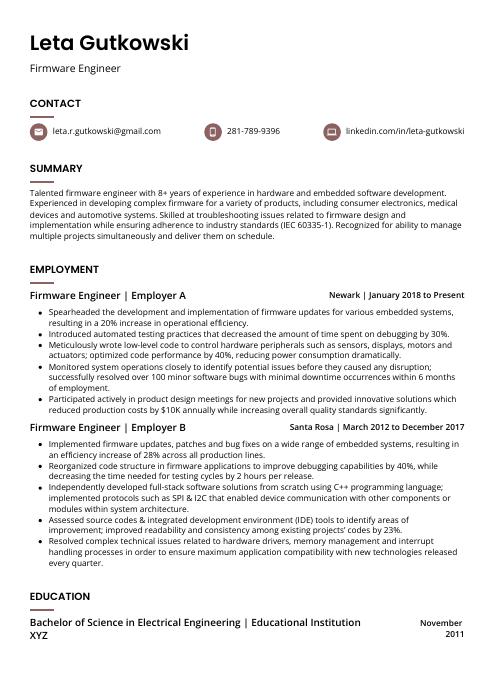 Fossa
Fossa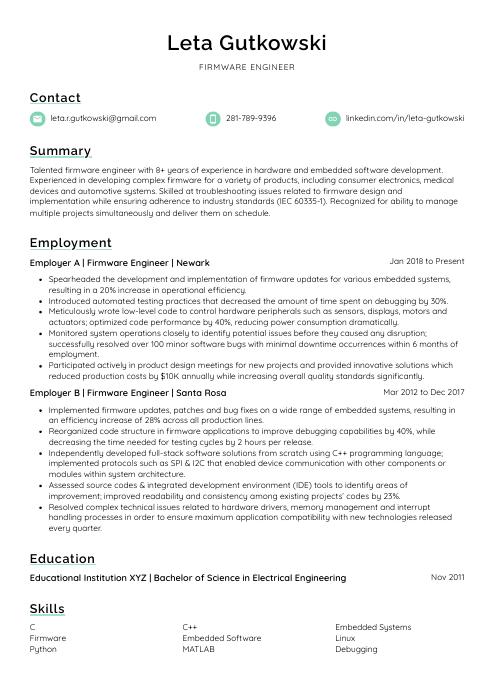 Lorikeet
Lorikeet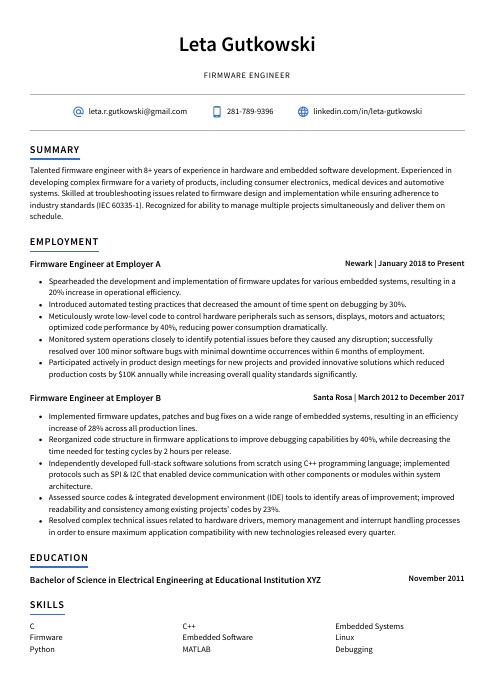 Axolotl
Axolotl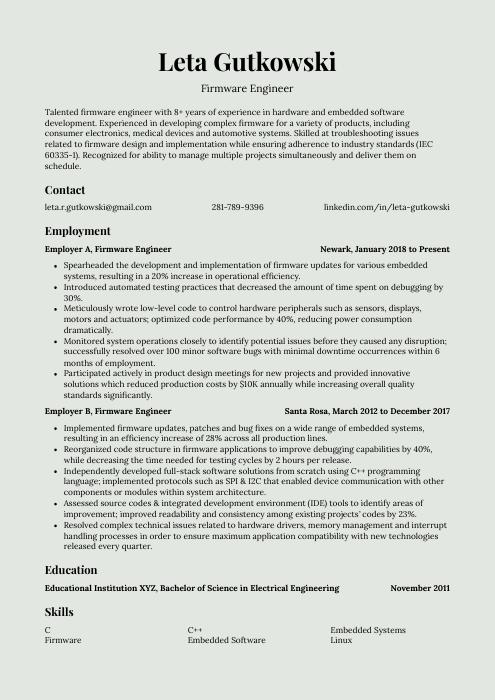 Saola
Saola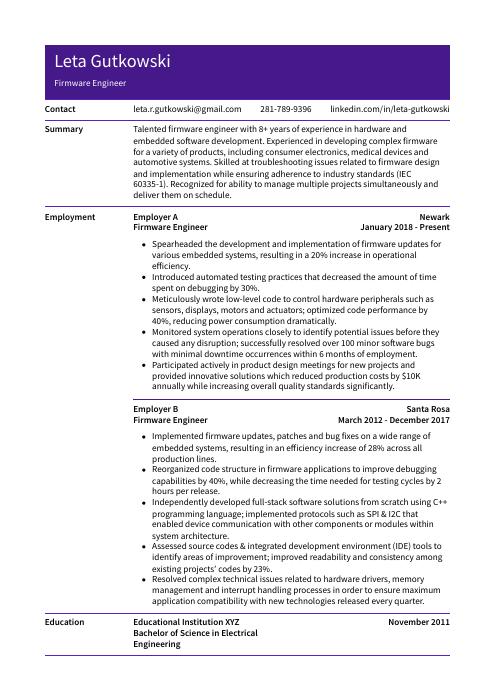 Pika
Pika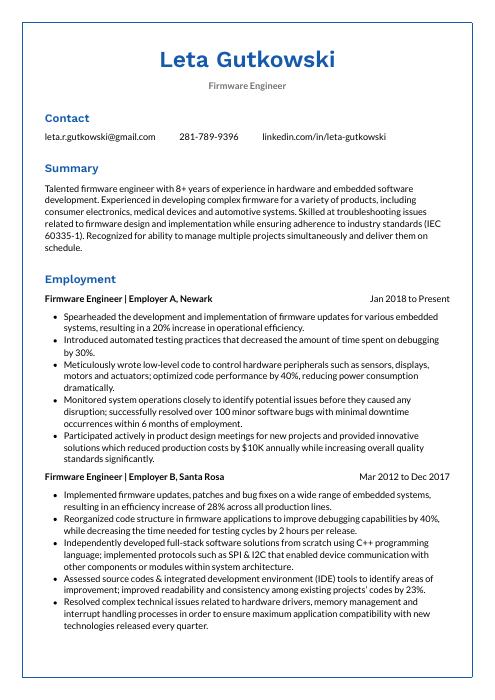 Markhor
Markhor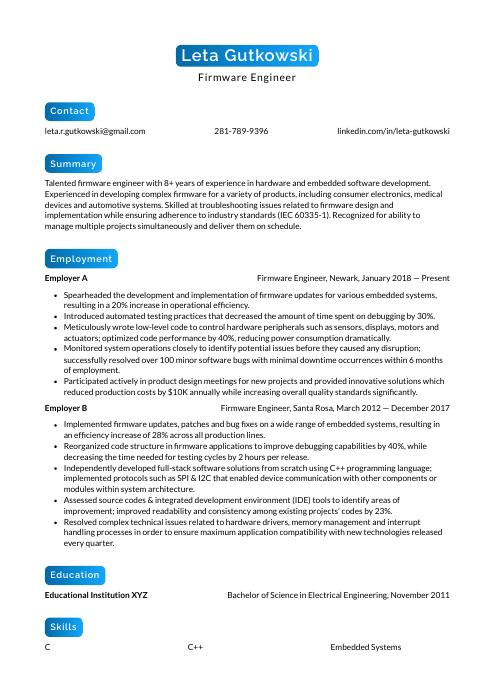 Kinkajou
Kinkajou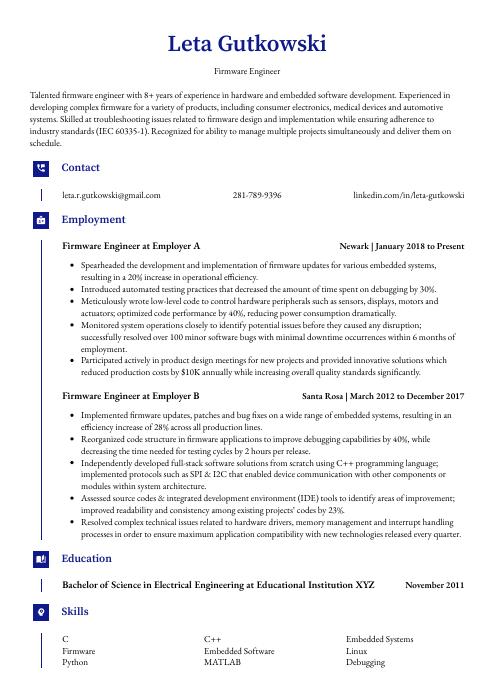 Gharial
Gharial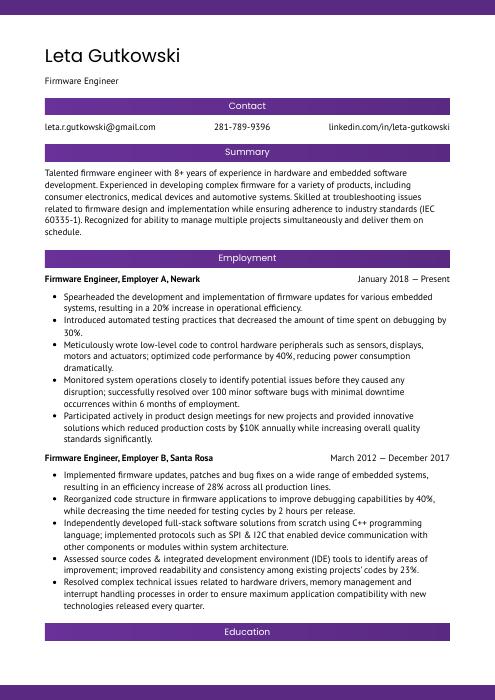 Jerboa
Jerboa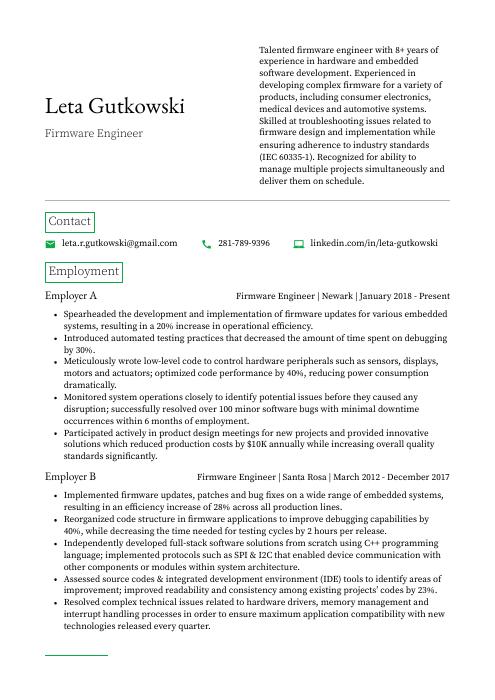 Quokka
Quokka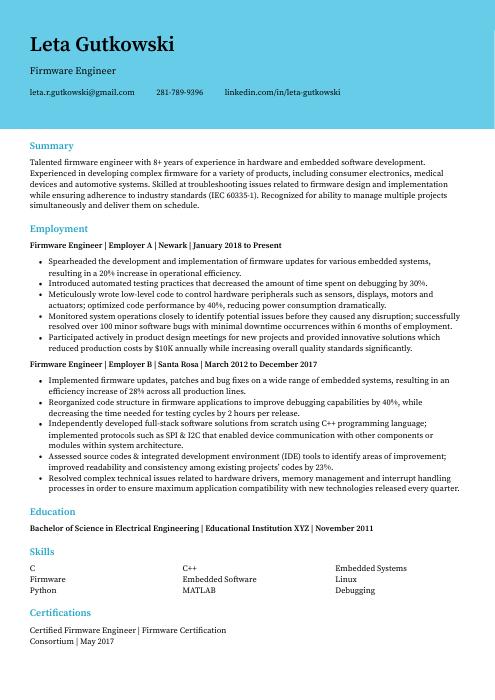 Dugong
Dugong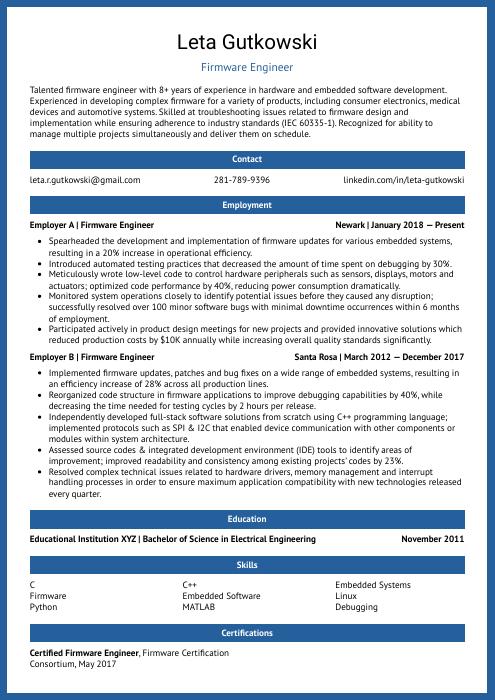 Ocelot
Ocelot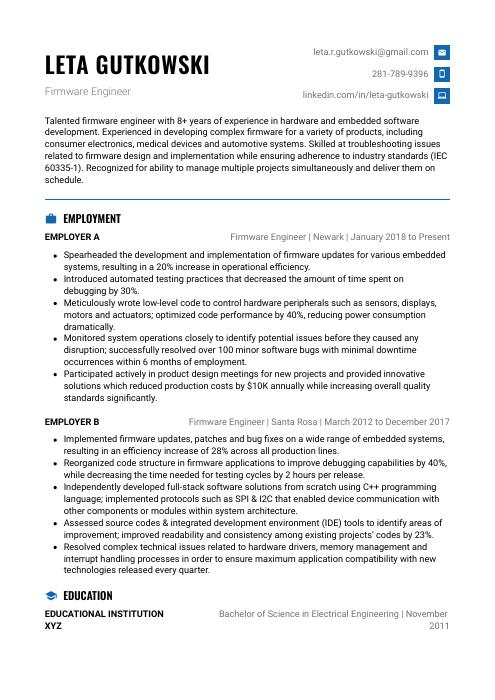 Echidna
Echidna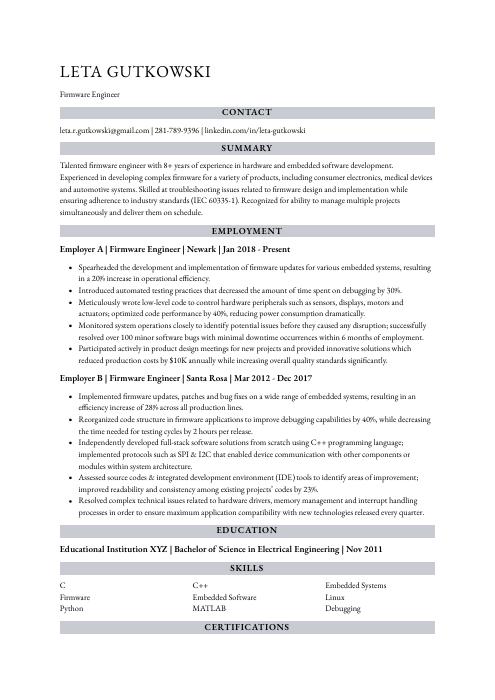 Numbat
Numbat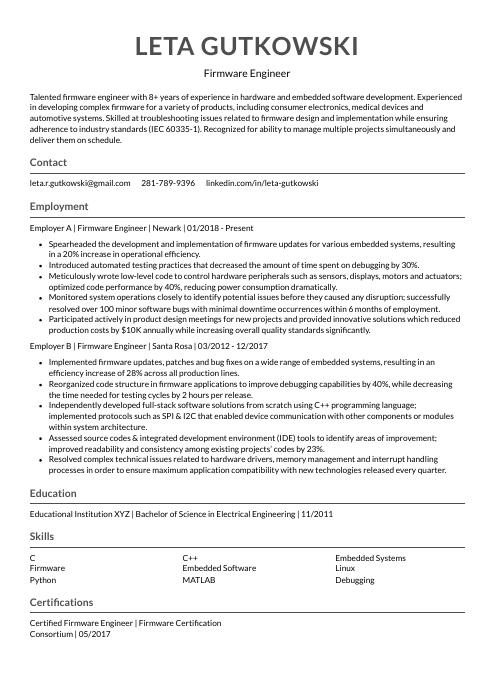 Indri
Indri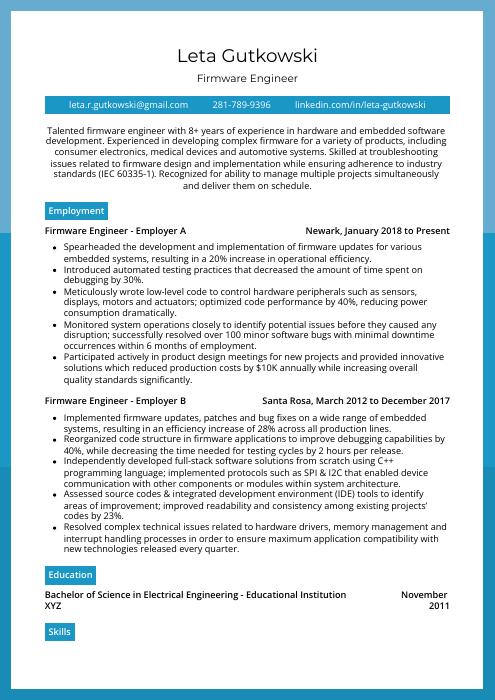 Rhea
Rhea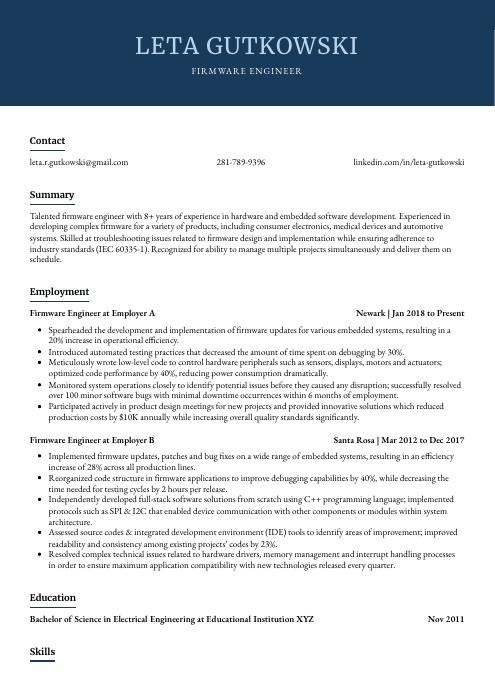 Bonobo
Bonobo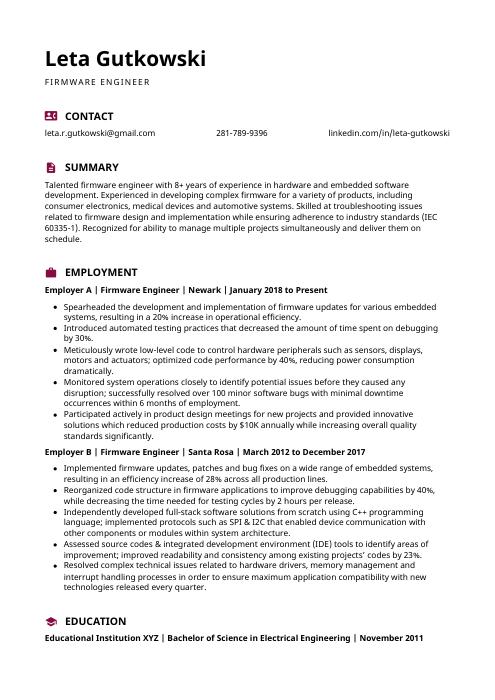 Hoopoe
Hoopoe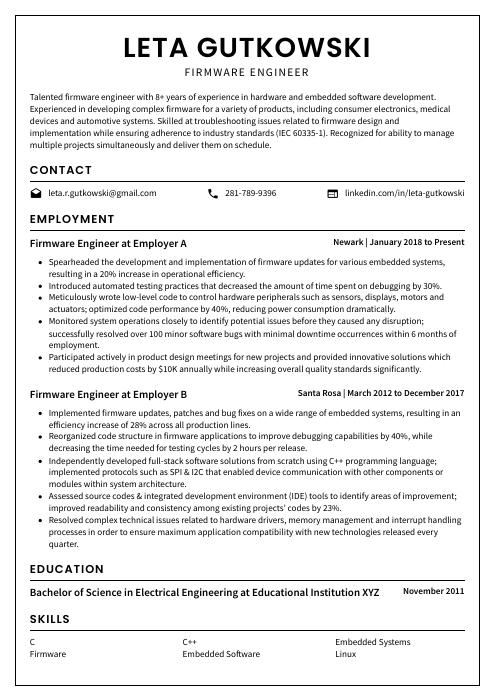 Cormorant
Cormorant Rezjumei
Rezjumei
